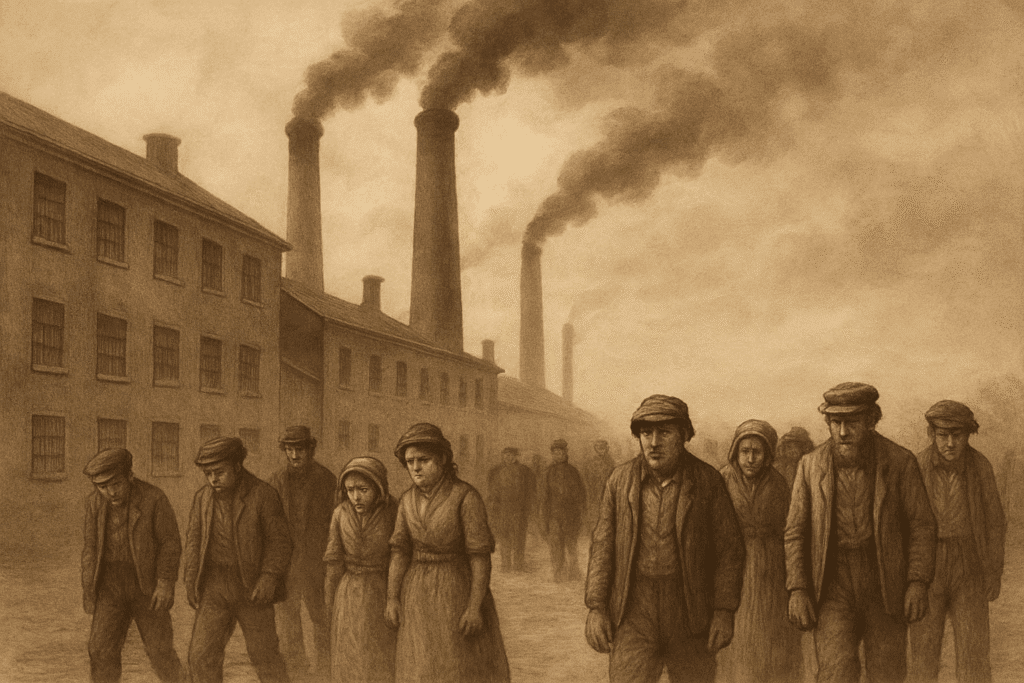Introduction

For generations, the 40-hour workweek has been held up as the ultimate benchmark for productivity — a symbol of hard work, discipline, and commitment. But if we pause and examine its origins, a surprising truth emerges: this standard was never crafted with today’s modern jobs in mind.
The concept of clocking in eight hours a day, five days a week, traces back to the industrial era. In the factories of the Industrial Revolution, long and grueling shifts were common, and the introduction of a standardized 40-hour week in the U.S. (thanks to the Fair Labor Standards Act of 1938) was a victory for workers’ rights. Its primary goal? To shield laborers from exploitation and prevent dangerous overwork.
Fast-forward to today, and the nature of work has transformed beyond recognition. We’re no longer operating assembly lines — we’re navigating complex problems, generating ideas, and relying on mental agility. Yet, we stubbornly cling to a system designed for a world of machines and manual labor.
What’s more, emerging research paints a clear picture: productivity doesn’t thrive on rigid schedules. In fact, studies consistently show that once we push beyond 35 hours a week, our efficiency drops, and the risk of burnout rises sharply. Instead of fostering innovation or well-being, the old model often traps workers in cycles of fatigue and disengagement — busy, yes, but far from truly effective.
The 40-Hour Workweek: A Legacy Shaped by Struggle, Not Science

The work schedule that so many of us take for granted today — the familiar 40-hour week — didn’t emerge from careful research into human productivity or well-being. Instead, it was the hard-won result of decades of worker resistance, social upheaval, and bold experimentation during a period when grueling, inhumane hours were the norm.
Let’s uncover the key moments that shaped this standard.
Early Calls for Balance: Robert Owen’s Vision
The idea that workers deserved time for rest and personal life began gaining traction in the early 19th century. In 1817, British social reformer Robert Owen introduced a powerful slogan that captured this hope: “Eight hours labor, eight hours recreation, eight hours rest.” This was a radical departure from the 80- to 100-hour workweeks that were common in factories of the time, where laborers endured exhausting conditions with little concern for health or dignity.
The Fight Intensifies: U.S. Labor Movements and the Haymarket Affair
By the mid-1800s, the push for shorter workdays spread across the Atlantic. In the United States, organized labor began demanding an eight-hour workday — but progress was slow and hard-fought. The tension reached a boiling point in 1886, when Illinois passed an eight-hour law that many employers simply ignored.
In response, workers launched a massive strike in Chicago, which ultimately led to the infamous Haymarket Riot. What began as a peaceful rally turned violent, leaving a deep scar on the labor movement but also solidifying the eight-hour day as a central demand in workers’ rights campaigns.
Industrial Innovation: Henry Ford’s Game-Changing Decision
While labor activists fought for shorter hours on moral and health grounds, industrialist Henry Ford took a different approach. In 1926, Ford Motor Company stunned the business world by slashing workweeks to 40 hours across five days — and doubling wages at the same time.
The gamble paid off. Instead of losing productivity, Ford’s factories saw gains. Employees were more loyal, turnover dropped, and the company’s output remained strong. Ford’s move helped shift public perception: fewer hours didn’t necessarily mean less work got done.
The 40-Hour Week Becomes Law
The final step toward the 40-hour week came through federal legislation. The Fair Labor Standards Act (FLSA), passed in 1938, was designed to protect workers from excessive hours without fair compensation. Initially, the law mandated overtime pay beyond 44 hours a week, but by 1940, this was lowered to 40 hours — the standard that remains in place today in the U.S.
A Standard That Was Never Meant to Define Human Limits
It’s important to remember: the 40-hour workweek was created as a safeguard against exploitation, not as a scientific formula for optimal performance or happiness. And yet, for nearly a century, we’ve clung to it as if it were a universal law of nature — often at the expense of flexibility, creativity, and well-being.
The Hidden Price We Pay for the 40-Hour Workweek

At first glance, the 40-hour workweek seems like a reasonable compromise — a structured balance between professional responsibilities and personal time. But when we look closer, the cracks begin to show. The model that once protected workers from exploitation is now silently fueling burnout, lowering productivity, and widening inequality. Let’s break down the true costs hidden beneath this outdated structure.
When Burnout Creeps In: The Danger Zone Beyond 39 Hours
It’s easy to assume that putting in a few extra hours means getting more done. But science tells a different story. Studies have shown that mental health starts to decline once weekly working hours surpass 39. Prolonged exposure to these extended schedules increases the risk of anxiety, depression, and chronic stress — conditions that harm not just employees, but the organizations that depend on their focus and energy.
Productivity’s Tipping Point: Why Less Can Deliver More
The idea that longer hours equal greater output is a myth that modern research has repeatedly debunked. Evidence from innovative experiments in countries like Sweden and Iceland reveals that shorter workweeks often sustain — or even enhance — productivity.
One standout example is Microsoft Japan, where a four-day workweek trial didn’t just maintain performance — it resulted in a staggering 40% jump in productivity. The lesson is clear: after roughly 35 hours a week, most knowledge workers hit a plateau where effort no longer translates into meaningful results.
The Illusion of Activity: How Presenteeism and Digital Distraction Erode Output
In many workplaces, employees feel an unspoken pressure to appear busy, even when genuine work is lacking. This leads to presenteeism — being physically present but mentally checked out — and the rise of cyberloafing, where digital distractions take over. The result? Teams that look active on the surface but achieve far less than their potential, all while draining their mental reserves.
Rigid Schedules, Disengaged Teams
Humans thrive on autonomy. Yet, the 40-hour template often leaves little room for flexibility. When workers are locked into rigid schedules, they lose control over how and when they perform their best work. Studies show that this loss of autonomy is a key factor in disengagement, lower job satisfaction, and higher turnover. On the flip side, when employees have the freedom to tailor their schedules, their engagement and performance levels soar.
The Unequal Burden: How the 40-Hour Model Overlooks Invisible Work
Perhaps one of the most overlooked flaws of the 40-hour system is how it ignores the invisible labor that many employees shoulder. Emotional support for colleagues, after-hours emails, caregiving responsibilities — these tasks often go uncounted but add significant strain, especially for women and marginalized groups. The result? An uneven distribution of labor that quietly fuels burnout and deepens workplace inequities.
The Future of Work: Moving Beyond the 40-Hour Template

The cracks in the 40-hour workweek are no longer theoretical — they’re visible in the rising rates of burnout, stagnating productivity, and growing demand for flexibility. But what’s next? Around the world, experiments with alternative work models are showing that we can build systems that serve both business goals and human well-being.
Four-Day Workweeks: More Rest, Better Results
Pioneering trials in countries like Iceland, New Zealand, and Japan have demonstrated that trimming the workweek doesn’t mean sacrificing output. In fact, the opposite often occurs. Iceland’s nationwide trials, for example, saw workers moving to 35–36 hour weeks without any loss in productivity — and in many cases, quality of work improved. Employees reported better work-life balance, reduced stress, and higher job satisfaction, creating a ripple effect of benefits across teams and communities.
Flexibility as a Productivity Tool
Beyond simply reducing hours, forward-thinking organizations are embracing flexible scheduling. This means allowing employees to design their workday around their natural rhythms, family needs, or even peak creative periods. When people are trusted to manage their own time, they tend to focus more on meaningful tasks rather than filling hours for appearances’ sake.
Tech firms, creative agencies, and even government departments are beginning to recognize that outcomes matter more than time spent at a desk. This shift reflects a deeper understanding: productivity is about energy, focus, and motivation — not clocking hours for the sake of tradition.
The Role of Technology in Reshaping Work
Advances in technology have made it easier than ever to move beyond rigid, outdated schedules. Cloud-based collaboration tools, AI-driven project management, and asynchronous communication platforms enable teams to stay connected and productive without needing to be in the same place or work the same hours.
These innovations are reshaping how work happens: employees can contribute when they’re at their best rather than being tied to arbitrary start and end times. This not only helps individuals manage their energy and mental health but also leads to higher-quality work delivered more efficiently.
Beyond Hours: The Shift Toward Outcome-Based Work
What truly matters in modern work isn’t the number of hours clocked — it’s the results. More companies are moving toward outcome-based performance models, where employees are evaluated on what they achieve, not how long they sit at a desk.
This approach helps eliminate the culture of “looking busy” and rewards genuine contribution, innovation, and problem-solving. It recognizes that real value comes from focused effort, creativity, and collaboration — not from simply being present for 40 hours a week.
A Call for Cultural Change
Ultimately, to move beyond the 40-hour workweek, we need more than policy shifts — we need a cultural transformation. It requires business leaders, policymakers, and workers alike to challenge old assumptions about what “work” should look like.
By embracing flexibility, trusting employees, and focusing on outcomes rather than hours, we can build workplaces that are not just more productive, but also healthier, fairer, and more sustainable for the long term.
Recommended Reads: Books That Challenge the 40-Hour Workweek
If you’re ready to explore deeper insights into how we can rethink work, here are some highly rated books available on Amazon that offer fresh perspectives on productivity, well-being, and the future of work. These books can help you (or your readers) discover practical strategies for moving beyond outdated models:
1️⃣ Shorter: Work Better, Smarter, and Less—Here’s How by Alex Soojung-Kim Pang
This eye-opening book explores real-world examples of companies that have successfully adopted shorter workweeks. With case studies from across industries and countries, Pang shows how working less can lead to greater innovation, happier employees, and sustainable success.
2️⃣ Deep Work: Rules for Focused Success in a Distracted World by Cal Newport
Cal Newport’s bestselling guide teaches how to harness focused, meaningful work in an age of constant distraction. While not about shorter hours directly, it complements the idea that productivity isn’t about time spent — it’s about how you work.
3️⃣ The 4-Hour Workweek: Escape 9-5, Live Anywhere, and Join the New Rich by Timothy Ferriss
A classic in the realm of work redesign, Tim Ferriss offers unconventional strategies to streamline tasks, automate income, and create more personal freedom. It challenges traditional notions of work and time management, inspiring readers to question the status quo.
4️⃣ Rest: Why You Get More Done When You Work Less by Alex Soojung-Kim Pang
In this companion to Shorter, Pang dives into the science behind rest and recovery — showing that rest isn’t the opposite of work, but an essential ingredient for sustained creativity and success.
5️⃣ Work Without Walls: An Executive’s Guide to Attention Management, Productivity, and the Future of Work by Maura Thomas
This practical guide focuses on modern work challenges, from information overload to managing virtual teams. Thomas provides actionable advice on creating healthier, more productive workplaces without relying on outdated structures.
Conclusion: It’s Time to Redefine Success at Work
For nearly a century, the 40-hour workweek has been treated as the default blueprint for success. But as we’ve explored, this model was born out of a very different time — one focused on protecting factory workers from exploitation, not on nurturing creativity, innovation, or well-being in today’s knowledge economy.
The evidence is clear: longer hours don’t equal better results. In fact, rigid schedules often harm mental health, stifle productivity, and fuel inequality. Around the world, experiments with shorter workweeks, flexible hours, and outcome-based approaches are proving that it’s possible to achieve more by working smarter — not longer.
The future of work isn’t about sticking to old templates. It’s about rethinking what makes us effective, fulfilled, and resilient in a rapidly changing world. For companies, that means building systems that prioritize trust, flexibility, and results. For individuals, it means embracing new ways of working that protect both our productivity and our well-being.
The 40-hour week served its purpose in history — but it shouldn’t define our future. The time has come to design work that works for us.
FAQ’s
Why was the 40-hour workweek originally created?
The 40-hour workweek emerged during the Industrial Revolution as a way to protect factory workers from dangerous, exploitative conditions. It became U.S. law in 1938 through the Fair Labor Standards Act, which aimed to prevent excessively long shifts and ensure fair pay — not to maximize creativity or well-being.
Is working more than 40 hours a week actually harmful?
Yes — research consistently shows that productivity tends to plateau after about 35 hours per week. Beyond that, the risk of burnout, stress, anxiety, and depression increases. Long hours may give the illusion of getting more done, but they often reduce the quality and sustainability of work.
Are shorter workweeks really more productive?
In many cases, yes. Trials in countries like Iceland, Sweden, and Japan have shown that reducing hours can maintain or even boost productivity. For example, Microsoft Japan’s four-day workweek experiment led to a 40% increase in output, along with happier, more engaged employees.
What’s the difference between flexible work and shorter workweeks?
A shorter workweek focuses on reducing total working hours, while flexible work allows employees to choose when and where they work. Both aim to improve well-being and productivity, but flexibility emphasizes autonomy and work-life integration rather than simply cutting hours.
How can companies start moving beyond the 40-hour model?
Companies can begin by shifting their focus from hours worked to results achieved. This might involve piloting shorter workweeks, offering flexible scheduling, training managers on outcome-based leadership, or using technology to enable more efficient, asynchronous collaboration.
Is the 40-hour workweek still required by law?
No — the 40-hour week is a standard for when overtime pay kicks in under U.S. law, but employers are not required to set a 40-hour schedule. Many organizations now experiment with alternatives as long as they comply with overtime and labor laws.
